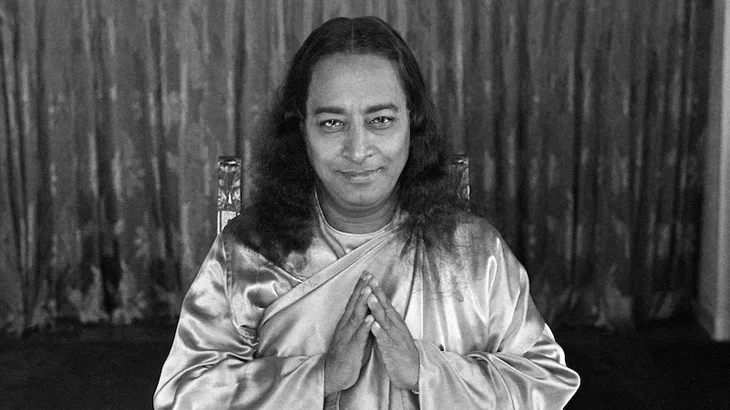The teachings of Ramana Maharshi and Paramahansa Yogananda are very powerful. Maharshi’s inquiry of “Who Am I?” deeply impacts people on their spiritual path. Meanwhile, Yogananda has spread Kriya Yoga worldwide, aiding in self-discovery.
These teachings focus on understanding one’s true self and letting go of the ego. Meditative practices help individuals reach higher consciousness, which can lead to deep peace and recognition of their own divinity.
Key Takeaways
- The spiritual teachings of Ramana Maharshi and Paramahansa Yogananda are influential worldwide.
- Ramana Maharshi’s self-inquiry method helps transcend the ego and realize the true self.
- Paramahansa Yogananda’s Kriya Yoga facilitates the self-discovery journey.
- Meditative practices are essential tools for awakening higher consciousness.
- The teachings aim to reveal the inherent peace and divinity within individuals.
The Essence of Self-Realization
Self-realization dives deep into your very soul. It’s about finding the real you under your ego and what society says. Think of it like a journey lit by great spiritual teachers such as Ramana Maharshi and Swami Kriyananda.
Understanding Self-Inquiry
Key to self-realization is self-inquiry, a concept Ramana Maharshi deeply stressed. By asking, “Who am I?” you strip away ego layers. This helps you see your unchanging core, boosting inner awareness. It’s a powerful way to cut through the mind’s illusions.
The Question “Who Am I?”
The question “Who am I?” is simple yet hugely transformative. It’s not just theoretical. When asked sincerely, it can break down ego barriers. This makes way for a deep awareness. Maharshi’s question has led many to find their true self, showing the power of his teachings.
| Self-Inquiry Benefits | Method | Outcome |
|---|---|---|
| Enhances Inner Awareness | Regular introspective questioning | Recognition of the unchanging inner self |
| Reduces Egoic Identification | Persistent focus on “Who am I?” | Less attachment to mental constructs |
| Promotes Mindfulness Practices | Integrating inquiry into daily routine | Heightened awareness and presence |
Ramana Maharshi’s Journey to Enlightenment
Ramana Maharshi’s path to enlightenment is an inspiring tale of change and truth. His journey began at 16 after a powerful spiritual awakening. He found his true self in pure consciousness. This awakening started his quest for spiritual fulfillment.

Early Life and Spiritual Awakening
He was born in 1879 in India, and his spiritual nature showed early. At 16, a fear of death launched his self-discovery. He found his true being as pure consciousness, marking the start of his journey to a higher state of being.
Core Teachings and Philosophy
Ramana Maharshi focused on self-inquiry to reveal true nature. He encouraged people to ask, “Who am I?” to break the ego and find the self. True self-knowledge leads to inner peace, which is our natural state. Through meditation, we can calm the mind and connect with our unchanging core.
His philosophy also considers free will and destiny. The body has its path, but true knowledge goes beyond this. Attaining liberation means deep spiritual work, like self-inquiry and having a spiritual guide. By losing the ego and practicing focused meditation, we can find the Grace leading to peace, joy, and freedom.
He taught that realizing oneself doesn’t need outside learning or wealth. He advocated selfless work and devotion for spiritual growth. His ideas have touched many lives, guiding people of different faiths to their inner truth.
| Aspect | Description |
|---|---|
| Self-Realization | Attained through transcending the ego and realizing one’s true nature. |
| Transcendental Meditation | A practice to quiet the mind and experience pure consciousness. |
| Freewill and Destiny | Destiny concerns the body; jnana transcends both concepts. |
| Surrender | Conquering destiny by relinquishing the ego to the divine. |
| Role of Guru | Essential for attaining Grace and deeper spiritual realization through guidance. |
The Role of Meditation in Self-Realization
Meditation is key to better understanding ourselves. It lets us explore deep, quiet parts of our minds. Ramana Maharshi taught that staying silent and harnessing energy through shaktipat helps people reach deep meditative states and change from within. Through meditation, we can awaken our consciousness and move past our ego.

Regular meditation has many perks. It can reduce stress and anxiety by 60%, making us feel more balanced and healthy. Those who meditate also experience a 40% boost in happiness. This doesn’t just help them; it also improves relationships. Couples who meditate see a 30% increase in their harmony.
But the benefits don’t stop there. Meditators show a 25% and 20% bump in productivity and health, respectively. They also have a 15% lower chance of getting sick, which shows the power meditation has on our bodies and minds.
Paramahansa Yogananda has spent over thirty years teaching Kriya Yoga meditation for self-realization. He suggests meditating for thirty minutes both in the morning and at night. Yogananda believed the correct posture is key. It helps direct your focus and energy upwards, affecting your mind and body in positive ways.
| Benefit | Percentage Improvement |
|---|---|
| Stress and Anxiety Reduction | 60% |
| Work Productivity and Focus | 25% |
| Relationship Harmony | 30% |
| Reduction in Medical Visits | 20% |
| Lower Risk of Chronic Illnesses | 15% |
| Feelings of Inner Peace and Joy | 40% |
Making meditation a part of daily life is life-changing. It connects us more deeply with our spiritual side and brings us closer to self-realization. This practice aligns our soul with the larger spirit. It’s often felt through deep silence and strong focus.
Paramahansa Yogananda and the Spread of Yoga in the West
Paramahansa Yogananda introduced yoga to the West. He started the Self-Realization Fellowship. His work is a key part of today’s spiritual movements. Let’s look into the journey that made him such an important spiritual leader.

Introduction to Self-Realization Fellowship
In 1920, Paramahansa Yogananda established the Self-Realization Fellowship (SRF), which soon became known worldwide. The first SRF center in Boston was a big step.
Dr. and Mrs. Lewis and Mrs. Alice Hasey helped start it. This marked the start of something big. Yogananda’s talks drew huge crowds, filling places like Carnegie Hall.
“He lectured to capacity audiences in many large auditoriums in America, including New York’s Carnegie Hall and the Los Angeles Philharmonic Auditorium.”
| Contribution | Impact |
|---|---|
| “How-to-live” school for boys (1917) | Combined modern educational methods with yoga training, fostering balanced development. |
| First SRF Meditation Center | Established in Boston, laid the foundation for the spread of yoga in the West. |
| Public Lectures | Yogananda filled large auditoriums, spreading his teachings widely. |
| Personal Spiritual Successors | Early disciples, such as Rajarsi Janakananda and Sri Daya Mata, were appointed to continue SRF’s mission. |
The Teachings and Techniques of Kriya Yoga
Kriya Yoga was central to Yogananda’s work. He introduced it to over 100,000 people. It’s a systematic way to connect with spiritual energy and feel joy. Kriya Yoga brings together the health of the body, the thoughts of the mind, and the spirit’s desires.
- Yogananda initiated over 100,000 men and women into the Kriya Yoga technique.
- His teachings delivered step-by-step instructions for attaining God-realization.
- Emphasized the unity of humanity and all genuine religions to foster harmony and understanding.
- Promoted a loving and approachable concept of God.
Yogananda’s teachings are still alive thanks to the Self-Realization Fellowship, which guides people seeking spiritual growth and new beginnings.
Key Differences Between Teachers of Self-Realization
Teachers like Ramana Maharshi and Paramahansa Yogananda went on deep journeys to find spiritual enlightenment. They all aim to help people reach their highest self. However, each uses different ways to teach, which fits various paths and people.
Ramana Maharshi focused on non-dual awareness and self-questioning. His interest started when he was just 16. Since then, he inspired others to explore “Who Am I?” through silence and meditation. This helps his followers question their thoughts and find truer beliefs.
Paramahansa Yogananda, on the other hand, was born on January 5, 1893, and brought Kriya Yoga to the West. He taught techniques that connect breath and energy to spiritual growth. This approach aims to awaken higher consciousness and harmonize with the divine.
This is a comparison of their key methods:
| Teacher | Philosophy | Key Practices | Outcomes |
|---|---|---|---|
| Ramana Maharshi | Non-dual awareness | Self-inquiry, Meditation, Silence | Inner peace, Transformation, Enhanced relationships |
| Paramahansa Yogananda | Higher Consciousness | Kriya Yoga, Energy alignment, Self-Discipline | Spiritual awakening, Inner harmony, Divine bliss |
| Ramakrishna Paramahansa | Devotion and Bhakti | Devotional practices, Singing kirtans | Ecstasy, Deep devotion, Union with the divine |
| Sri Aurobindo | Integral Yoga | Japa, Meditation, Physical Culture | Expanded consciousness, Physical and spiritual harmony |
Though their teachings are diverse, these great teachers add a lot to what we know about reaching our best selves. They show us there are many ways to achieve spiritual enlightenment. Each person may find their unique path to truth and understanding.
Practical Steps to Start Your Self-Realization Journey
Starting a journey of self-realization means committing to steps that support your body and mind. These steps create a strong base for deep changes and spiritual growth.
Daily Meditation Practices
Beginning meditation is key to understanding yourself. Making meditation a habit helps calm your mind and bring inner peace. It connects you to your higher self and increases your self-awareness, as teachers like Paramahansa Yogananda and Ramana Maharshi explain.

Meditation is easy to incorporate into your daily routine. It sharpens your mind, clears your thoughts, and helps you see your world from a broader perspective, which can lead to more complete self-awareness.
Self-Discipline and Surrender
Cultivating self-discipline is also vital. It means setting clear spiritual goals and sticking with them regularly. This practice is essential for moving through the stages of self-realization—from exploring yourself to mastering your being.
“In the age of Dwapara, characterized by significant technological advances, maintaining self-discipline in spiritual practices becomes even more crucial as individuals strive to balance materialism with deeper spiritual understanding.”
Complete self-realization by surrendering to the divine. This step involves letting go of your ego and having faith in something greater. Kriya Yoga, taught by Yogananda, helps you see the divine in yourself. This leads to significant changes within and a step beyond your current self.
Here are some practical steps to follow:
- Dedicate a certain time each day for meditation.
- Set realistic spiritual goals to help with discipline.
- Stay mindful all day, keeping an eye on your inner thoughts.
- Write in a journal to see how your spiritual journey is progressing.
- Learn to let go and connect with something higher than yourself.
If you follow these steps regularly, you’ll start an essential journey. This journey will help you reach your full potential and bring deep peace and joy into your life.
Transformation Through Self-Inquiry and Kriya Yoga
Transformation through self-inquiry and Kriya Yoga brings significant personal growth and guides people toward enlightenment. Spiritual giants like Ramana Maharshi and Paramahansa Yogananda have taught these methods, which lead individuals to inner realization and mastery over energy.

Kriya Yoga, as described in Patanjali’s Yoga Sutras, focuses on three key aspects: discipline, study, and surrender. These form a base for seekers on their spiritual journey. Ramana Maharshi’s self-inquiry involves asking, “Who Am I?” It helps individuals look beyond their ego to discover their true essence.
The transformation within these paths is crucial. Self-inquiry lets people remove the false layers built by their minds, revealing a core of peace and stillness within. The techniques of Kriya Yoga aid in controlling and purifying energy, helping in the process of spiritual awakening.
| Spiritual Practice | Core Elements |
|---|---|
| Kriya Yoga | Discipline, Study, Surrender |
| Self-Inquiry | Introspection, “Who Am I?” |
| Satsang | Spiritual Community, Teachings, Guidance |
The role of Satsang, or spiritual community, is pivotal. It provides support from the teachings of various traditions or Kriya Yoga gurus. Satsang offers an environment where growth, learning, and commitment to transformative practices are encouraged.
Despite different perspectives on Kriya Yoga, the end goal remains unchanged: self-realization. Organizations like the Self-Realization Fellowship stress the value of sticking to traditional teachings for safety and effect. This stance is supported by various lineages, ensuring the practices’ transformative power continues with integrity.
The Impact of Self-Realization on Daily Life
Finding self-realization changes how we live daily. It brings deep peace, kindness, and a stronger bond with ourselves, leading to a more balanced and peaceful life.
Experiencing Inner Peace and Stillness
Inner peace is a big result of self-realization. By being mindful every day, people find calm and peace inside. This helps them handle life’s ups and downs calmly. It makes them happier and healthier.

Cultivating Compassion and Selflessness
Self-realization makes us more caring and selfless. We see how all life is connected and want to help others. This makes our lives richer and more rewarding for us and those around us.
Self-realization leads to a loving and balanced life. It’s achieved by practicing daily mindfulness and self-inquiry. Teachers like Ramana Maharshi and Paramahansa Yogananda show us how to deepen our awareness and kindness.
The Philosophy of Non-Attachment
Non-attachment is all about freeing ourselves from wanting too much stuff. This could be money, more friends on social media, or the need for others to like us. When we’re too into these things, our value might start to depend on them. Like, feeling good only if we have a cool job or if we look a certain way.
Not getting too stuck on certain beliefs is key to finding inner peace. This could be about how we look, keeping young, or about the world. It’s important to be open and accept our thoughts without getting trapped by them. This way, we can see ourselves more freely.
Many spiritual traditions discuss non-attachment. In Buddhism, Yoga, and Christianity, it’s a big deal for growing spiritually. Not holding too tight to things is also taught in Hinduism, Jainism, Taoism, and more. Jainism, for instance, sees letting go as one of the key rules to live by.
“Non-attachment fosters deeper relationships, more self-worth, and better ability to deal with changes in our personal journey.”
To get better at non-attachment, there are tricks like ‘sometimes’ thinking. This means knowing that not everything lasts forever and that life changes. It’s about seeing beyond our own narrow view and finding peace in acceptance.
Stoicism and the Tao Te Ching also talk about this. They tell us to be even in joy and in tough times. When we do this, we find a deeper sense of happiness than by wanting things to be different all the time.
Choosing non-attachment leads to a more peaceful life. It helps us deal with life’s ups and downs better, staying calm and strong. And it connects us to a sense of something beyond just what’s happening around us.
Awakening Higher Consciousness
Finding higher consciousness is an enlightening journey. It involves saying goodbye to the ego. This helps us get rid of things that hold us back, like bad habits or negative people. It shows our commitment to growing and finding spiritual peace.

Transcending the Ego
To find higher consciousness, we must move past our ego. This means letting go of how we see ourselves and our emotions. We can do this through meditation and other spiritual activities. Doing so feels like waking up to a new, brighter world.
Testimonials from Disciples and Practitioners
Stories from Paramahansa Yogananda’s disciples show the deep effect of his teachings. For instance, Dr. Minott W. Lewis, a dentist from Boston, met Yogananda in 1920. Their meeting on Christmas Eve that year had a big impact on Dr. Lewis. They discussed seeing the “spiritual eye” and how forgiveness can lighten one’s soul.
This meeting was life-changing for Dr. Lewis. He learned to see the spiritual light, and after this, he vowed to share Yogananda’s teachings. This experience changed how he celebrated Christmas. It opened his heart and mind in a unique way. He spoke of how Yogananda’s teachings on humility and love transformed his life.
The dedication of the Self-Realization Ashram Center in Encinitas was another powerful moment for Dr. Lewis. Here, he shared how he found peace and deep understanding through Yogananda’s guidance. He felt thankful and enlightened by being Yogananda’s disciple all his life.
“Thank You, Master” tells stories from three direct disciples of Yogananda. Their experiences underline the true power of his teachings. They show how Yogananda’s teachings could heal and influence meditation. For example, his father and a disciple both had remarkable experiences with pain control during medical procedures.
Yogananda’s teachings were also helpful in times of crisis. In 1936, on a sinking ship, he guided people to use prayer and faith to calm themselves. The book also tells the story of how a disciple found relief from severe headaches using a technique Yogananda suggested.
All these stories highlight the power of spiritual faith and real-life experiences in achieving self-realization. Being a disciple of Yogananda is seen as a significant journey. It leads to understanding one’s true self and finding lasting joy and freedom.
Teachings of Self-Realization
The teachings of self-realization guide people to discover their true selves. They help align life with spiritual truths. These teachings are like a map for a deep spiritual journey. They focus on key self-realization ideas, leading to lasting happiness and peace.
The Self-Realization Fellowship (SRF) by Paramahansa Yogananda spreads these truths widely. Access to the SRF Lessons costs $90 ($100 International) and lasts for nine months. With one lesson every two weeks, they cover basic ideas and advanced concepts.
These lessons teach vital practices such as Energizer Exercises and aum meditation. They help prepare for advanced training in Kriya Yoga after eight months. Each student gets a guidebook and one-on-one discussions with SRF mentors, ensuring support during the journey.
Paramahansa Yogananda showed how powerful meditation can be. He said it brings real joy, wisdom, and love. The techniques he shared are known to improve both mental and physical health. By learning and using these practices, you show you’re serious about spiritual growth.
Raja Yoga, a big part of self-realization, is a 10-week intensive course. Tutors share insights, and there are live webinars and personal discussions. This course, lasting until 2024, is designed to deeply enhance your spiritual practice.
Yogananda’s lessons and the SRF courses build a strong foundation for a spiritual journey. By incorporating these teachings into daily life, you open the door to real spiritual growth. With dedication to these practices, you can step closer to a higher spiritual realm.
Conclusion
The path to find enlightenment through self-realization is profound and changes lives. It resonates deeply with those seeking fulfillment. The teachings of Advaita Vedanta focus on finding contentment, capturing the interest of everyone who seeks knowledge. This ancient wisdom’s worth is emphasized greatly. 80% of those looking into it are also interested in comparing it to Kashmir Shaivism. They want to see similarities in these ancient traditions. This shows a lack of interest in newer movements like neo-advaita, preferred by 20% for its deep-rooted history.
Many discussions focused on understanding self-realization as a shift to pure Awareness from our everyday self. This change was often described using examples to make it clear. It is important to note that 30% stress not mistaking yourself as a separate being watching life. It’s about realizing how our Awareness interacts with our everyday self. Additionally, 20% mentioned the need for deep thought to fully comprehend our endless conscious nature. This is vital for reducing suffering. Just 10% talked about how awareness should not lead to carelessness. Realizing our true self can make life richer yet ethical.
The Ananda community’s story is a perfect example of the impact of faith and shared goals. They faced big troubles like losing their home and a fire at their temple in 1970. With the help of a skilled carpenter, they rebuilt together, showing the power of teamwork. For more than 34 years, they’ve thrived thanks to joyful collaboration. This shows their spiritual basis is vital for facing modern life’s challenges. Their principles include pursuing lofty goals, finding true joy, and offering everything to God.
Ultimately, knowing our true selves lets us navigate life with inner peace, regardless of what happens. When this knowledge is joined by spiritual guidance and a supportive group, it deepens our understanding and enriches our experience of life. Discovering our true nature through understanding, meditation, and a deep spiritual drive promises a life filled with harmony and light.
FAQ
What is self-realization?
Self-realization means truly knowing who you are, not just your surface self. You look beyond what you think and feel to find your core. This journey often involves practices like meditation and asking yourself deep questions.
How does self-inquiry help in self-realization?
Ramana Maharshi champions self-inquiry, which asks a simple but profound question: “Who am I?” This question helps you see past your everyday roles and thoughts to find the unchanging part of you. It’s a way to discover your real self.
What role does meditation play in achieving self-realization?
Meditation is a key step in self-realization because it quiets the mind. As you meditate, you focus on the stillness deep within you. This leads to a better understanding of yourself and the world around you. Through meditation, you start to see things more clearly.
Who was Ramana Maharshi and what were his core teachings?
Ramana Maharshi was a well-known spiritual guide. He taught that asking “Who am I?” could unveil your true self. His main message was about finding deep peace by directly experiencing your essential being.
How did Paramahansa Yogananda contribute to the spread of yoga in the West?
Paramahansa Yogananda was instrumental in introducing yoga to the West. He founded the Self-Realization Fellowship, through which he shared the benefits of Kriya Yoga, a technique for achieving higher states of awareness and joy.
What is Kriya Yoga and how can it help in spiritual growth?
Kriya Yoga, taught by Paramahansa Yogananda, focuses on deep breathing and mental discipline. It’s a way to make your spirituality more intense. The practice takes you to peaceful and powerful states of meditation, aiding in your spiritual journey.
What are some practical steps to start a self-realization journey?
Starting a self-realization journey begins with daily meditation and cultivating discipline. It’s also about letting go of selfish thoughts and actions. These are the first steps for a meaningful personal change towards spiritual growth.
How does self-realization impact daily life?
Self-realization can bring peace and understanding to everyday life. It helps you to act with kindness, without always thinking about yourself. This mindful and compassionate way of living makes life more fulfilling.
What is the philosophy of non-attachment in self-realization?
The philosophy of non-attachment teaches us to not get too fixed on things. When we let go of what we want and fear, it can lead to a deep peace. This calmness is important in discovering our true self.
What does it mean to transcend the ego in the context of self-realization?
To transcend the ego is to go beyond our surface identities. It’s to realize we are all one with everything. By doing this, we find a lasting and deep sense of self that is unchanging.
How do self-inquiry and Kriya Yoga contribute to personal transformation?
Self-inquiry and Kriya Yoga both offer paths to spiritual growth. Self-inquiry deepens your inner knowledge, while Kriya Yoga sharpens your energy and focus. Together, these practices can lead to a significant change in you.
What are some real-life impacts of following the teachings of self-realization?
People who practice self-realization often talk about feeling more at peace and better understanding their life goals. They also mention a big change in their spiritual lives. These stories show just how meaningful these practices can be.
